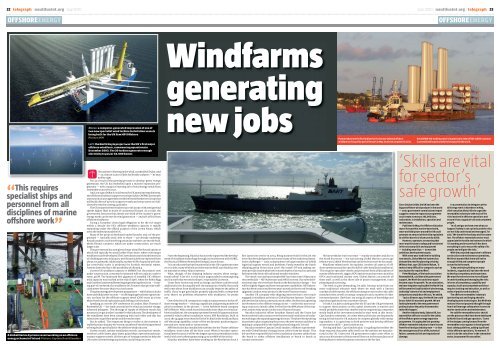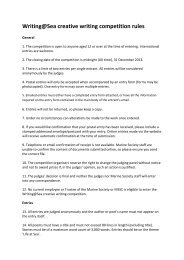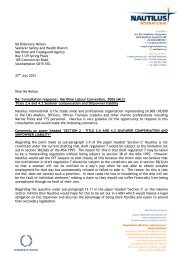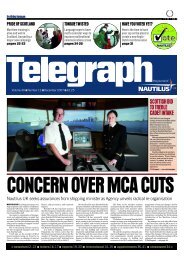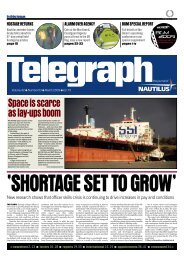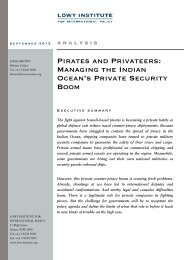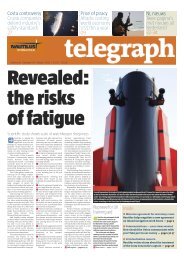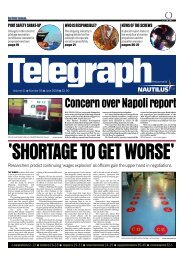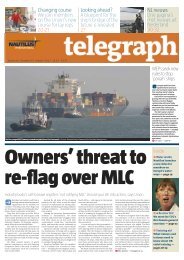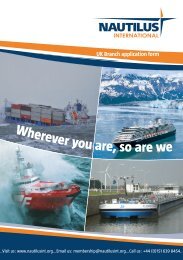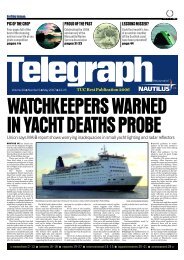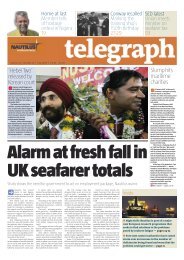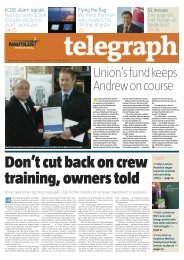You also want an ePaper? Increase the reach of your titles
YUMPU automatically turns print PDFs into web optimized ePapers that Google loves.
22 | telegraph | nautilusint.org | July 2010 July 2010 | nautilusint.org | telegraph | 23<br />
OFFSHORE ENERGY<br />
OFFSHORE ENERGY<br />
“<br />
This requires<br />
specialist ships and<br />
personnel from all<br />
disciplines of marine<br />
offshore work<br />
”<br />
A Global Marine Systems vessel working on an offshore<br />
energy scheme in Finland Picture: Captain David Sanders<br />
Above: a computer-generated impression of one of<br />
two new specialist wind turbine installation vessels<br />
being built for the UK firm MPI Offshore<br />
Picture: MPI<br />
Left: the North Hoyle project was the UK’s first major<br />
offshore windfarm , commencing operations in<br />
December 2003. The 30 turbines generate enough<br />
electricity to power 40,000 homes<br />
C<br />
The answer is blowing in the wind, croaked Bob Dylan. And<br />
— as a future source of jobs for British seafarers — he may<br />
well be right.<br />
For, as a result of the growing pressure to develop ‘green’ energy<br />
generation, the UK has embarked upon a massive expansion programme<br />
— with a target of meeting 15% of total energy needs from<br />
renewable sources by 2020.<br />
And, as a sign of what it could mean for UK maritime employment,<br />
the offshore wind farm support vessel specialists OWPMS last month<br />
announced a £30m agreement with the Brook Henderson Group that<br />
will build a fleet of up to 60 support vessels and create some 200 fulltime<br />
jobs over the coming 24 months.<br />
The UK enjoys the best wind resource in Europe, with average wind<br />
speeds higher than in much of continental Europe. As a result, the<br />
government forecasts that almost one-third of the country’s ‘green’<br />
energy needs can be met by wind generation — and 19% of this from<br />
offshore windfarms.<br />
Facing a European Union legal obligation to hit the 15% target<br />
within a decade, the UK’s offshore windfarm capacity is rapidly<br />
expanding under the official auspices of the Crown Estate, which<br />
owns the seabed around the UK.<br />
Many of the projects developed under Rounds 1 and 2 of the programme<br />
— typically sited close to shore — are already underway.<br />
Round 1 projects, each involving around 30 turbines, are mostly built,<br />
whilst Round 2 projects, which are under construction, are much<br />
larger scale.<br />
The government has now given the go-ahead for Round 3 projects<br />
which will typically be sited further from shore, where even larger<br />
windfarms can be developed. The Crown Estate announced the results<br />
of a bidding process in January, with Round 3 delivery expected from<br />
about 2014 onwards. Additionally, another 6GW of capacity with similar<br />
time-build scales is projected for Scottish territorial waters.<br />
Further down the line is the possibility of a Round 4.<br />
Current UK windfarm capacity is 688MW, but the projects now<br />
under construction, consented or planned will see capacity vault to<br />
some 47GW. The landmark first gigawatt of installed UK offshore<br />
wind capacity was reached at the end of April, when the Robin Rigg<br />
and Gunfleet Sands windfarms began generating electricity — forming<br />
part of a network of 11 windfarms in UK waters that provide sufficient<br />
power for more than 700,000 homes.<br />
The green energy development programme — which also includes<br />
wave and tidal power sources — is offering huge business opportunities,<br />
not least for the offshore support vessel (OSV) sector at a time<br />
when North Sea oil exploration and drilling is on the wane.<br />
Speaking at a recent OSV conference in London, Rhys Thomas of<br />
RenewableUK — the trade association for wind and marine energy,<br />
informed delegates: ‘The shortage of supply of offshore vessels has<br />
meant you’ve got a sellers’ market for this industry. The developers of<br />
the windfarms have been competing with each other and this has<br />
raised costs to get their projects delivered on time.’<br />
But he added: ‘The important thing to realise at the moment is<br />
really that since January we’ve seen a number of vessels being ordered<br />
or being built specifically for the offshore wind industry.’<br />
Survey vessels, turbine installation vessels, construction vessels,<br />
trenchers, cable-layers, pipe-layers, guard ships, operation and maintenance<br />
support vessels: all the types of tonnage needed to help the<br />
UK realise its wind energy aspirations, and all require crews.<br />
Windfarms<br />
generating<br />
new jobs<br />
From the beginning, <strong>Nautilus</strong> has actively supported the development<br />
of windfarm technology through its involvement with NOREL,<br />
the Nautical Offshore Renewable Energy Liaison forum.<br />
‘It is an industry that has the potential in the UK to generate some<br />
70,000 jobs, many of which are in the marine field,’ says <strong>Nautilus</strong> senior<br />
national secretary Allan Graveson.<br />
What, though, of the shipping industry anxiety about navigational<br />
safety? ‘A lot of it is very much ungrounded scaremongering<br />
and is a myth that we need to dispel,’ responds Mr Graveson.<br />
‘Some ferry routes may need to change, and there could be small<br />
additional costs. But equally well, the separation of traffic that could<br />
well come about from windfarms can actually improve the safety of<br />
traffic. If you’ve got good radar, properly adjusted with a competent<br />
crew, there’s no problems whatsoever with windfarms,’ he points<br />
out.<br />
One of the first UK companies to stake a major presence in the offshore<br />
energy market — creating a significant and growing number of<br />
jobs for seafarers in the process — is the Yorkshire-based company<br />
MPI Offshore. With a track record that totals more than 200 wind turbine<br />
installations, the company operates the world’s largest and most<br />
powerful wind turbine installation vessel, MPI Resolution. Built in<br />
2003, the 14,547gt vessel was the first of its kind in the world and has a<br />
self-elevating capability, a state-of-the-art dynamic positioning system<br />
and 300-tonne and 50-tonne cranes.<br />
MPI Resolution has installed the turbines for the Thanet offshore<br />
windfarm, some 12km off the Kent coast. When it becomes operational<br />
later this year, it will be the largest operational windfarm in the<br />
world, with 100 turbines generating up to 300MW of electricity.<br />
<strong>Nautilus</strong> members have been working on the Resolution since it<br />
first came into service in 2004. Being purpose-built for the job, the<br />
vessel has been designed to overcome many of the traditional installation<br />
challenges — such as dependence on large numbers of infield<br />
logistical support vessels and problems. Partly owned by the Dutch<br />
shipping group Vroon since 2006, the vessel’s DP and jacking systems<br />
provide a stable platform in water depths of as much as 35m and<br />
far beyond the limits of traditional weather windows.<br />
The vessel’s success has prompted MPI to invest some US$550m in<br />
two newbuilds — MPI Adventure and MPI Discovery. Due to be delivered<br />
next year, the vessels are based on the Resolution’s design — but<br />
will be slightly bigger and have even greater capabilities. MPI Adventure<br />
has been contracted for two years to work on the record-breaking<br />
1gigawatt London Array project in the outer Thames estuary.<br />
Another UK company with shipping interests that is very much<br />
engaged in windfarm activities is Global Marine Systems. Traditionally<br />
involved in subsea communication cables, the firm has a growing<br />
involvement in the offshore energy sector — earlier this year securing<br />
a contract to install cables for the first 630MW phase of the massive<br />
London Array project in the outer Thames Estuary.<br />
<strong>Nautilus</strong> industrial officer Jonathan Havard said the Union has<br />
been involved in discussions over the terms and conditions of seafarers<br />
working in the expanding energy division. ‘They have been putting<br />
incentives in place to get people across to the new venture and they’re<br />
making it comparable to the traditional seafaring role,’ he said.<br />
<strong>Nautilus</strong> member Captain David Sanders, offshore superintendent<br />
with Global Marine’s Energy Sector, tells it from the inside: ‘This<br />
job involves responsibility for the installation of power cables from<br />
the beach to either offshore installations or beach to beach as<br />
country connectors.’<br />
Pictured above are the first turbines for the Greater Gabbard offshore<br />
windfarm arriving in the port of Harwich in May. Due to be completed in 2012,<br />
He has worked at sea for 30 years — mainly on tankers and also in<br />
the North Sea sector — but says joining Global Marine 13 years ago<br />
(when it was Cable & Wireless) was easily the best move he has made.<br />
Windfarm-related work, he explains, involves all aspects of offshore<br />
operations and the specific skill of cable installation and burial.<br />
‘This requires specialist vessels and personnel from all disciplines of<br />
marine offshore work: riggers, ROV operators and surveyors as well as<br />
DPOs and traditional marine crew. Global Marine can provide all<br />
these staff, as well as the shore side of project management, route<br />
planning and surveying.<br />
‘The work is quite demanding,’ he adds, ‘because aside from our<br />
more traditional telecoms work where we work with a limited<br />
number of cable owners, the offshore energy sector involves the cable<br />
manufacturers as well as energy companies and a number of other<br />
interested parties. I feel that I am using all aspects of knowledge and<br />
experience gathered over a number of years.<br />
‘I think it is a particularly good for the EU and the UK government<br />
to support these projects as the capital investment is massive and<br />
would probably mean that smaller marine engineering companies<br />
would baulk at the investment needed to start work in this sector,’<br />
Capt Sanders comments. ‘At a time when politicians are desperately<br />
trying to find ways for UK industry to compete globally with emerging<br />
markets, it is a good way to both preserve and develop offshore<br />
sector marine skills — particularly at sea.<br />
‘Having said that,’ Capt Sanders adds, ‘it is galling that neither the<br />
ships required, the power cable itself, nor the turbines are manufactured<br />
in the UK. Unless the UK government makes some effort to<br />
attract such business to Britain we will lose out in the manufacture of<br />
the hardware to other European countries or the Far East.’<br />
the 500MW 140-turbine project is located some 23km off the Suffolk coast and<br />
is presently the largest windfarm being built in the world.<br />
‘Skills are vital<br />
for sector’s<br />
safe growth’<br />
Since October 2008, the UK has been the<br />
biggest offshore wind producer in the world<br />
— and a government-commissioned report<br />
suggests a massive expansion programme<br />
could create as many as 145,000 jobs,<br />
nationwide, in installation, operation and<br />
maintenance.<br />
Published in May, the Offshore Valuation<br />
report forecast that marine-based wind,<br />
wave and tidal power around the UK could<br />
generate an amount of electricity equivalent<br />
to a billion barrels of oil per year by 2050.<br />
However, operators are warning that<br />
more must be done to safeguard investment<br />
in the necessary skills and equipment<br />
— including new ships — to meet the<br />
ambitious development targets.<br />
With a two-year lead time for building<br />
new vessels, Global Marine Systems has<br />
stressed the need for planning certainty.<br />
Without that, says CEO Gabriel Ruhan, ‘it<br />
makes it very difficult for companies such as<br />
ours to plan the required fleet’.<br />
Peter Madigan, of the trade association<br />
RenewableUK, said that with government<br />
support, the North Sea could once again<br />
become a spur for growth. ‘As an association,<br />
we have long been saying that the North Sea<br />
will become the Saudi Arabia of wind energy,<br />
and today’s tonne of oil and employment<br />
comparisons amply bear this out,’ he added.<br />
‘Just as 30 years ago, the North Sea could<br />
be our ticket for economic growth. We are<br />
looking forward to the new government<br />
putting in place the policy framework to<br />
make this happen.’<br />
Another industry body, Subsea UK, has<br />
warned that skills are crucial for the safety<br />
of the offshore green energy expansion<br />
programme. It is urging the fast-growing<br />
offshore renewable industry to learn lessons<br />
from the oil and gas industry now — or face<br />
the consequences of loss of life, technical<br />
failure, commercial risk and reputational<br />
damage.<br />
In a presentation to delegates at the<br />
All Energy event in Aberdeen in May,<br />
chief executive Alistair Birnie urged the<br />
renewables industry to take stock of the<br />
risks involved in offshore operations and<br />
ensure it has a supply of safe and competent<br />
people.<br />
‘In oil and gas we have seen what can<br />
happen if safety is not a priority and the risks<br />
are not fully understood and managed,’ he<br />
said. ‘We learnt the hard way and lives were<br />
lost. The offshore renewables sector must<br />
appreciate the hostile environment in which<br />
it is working and ensure that it has done<br />
everything it can to ensure the safety of its<br />
people and mitigate the risks.’<br />
With the projected expansion in offshore<br />
construction and maintenance operations,<br />
Mr Birnie warned that there will not be<br />
enough skilled and competent people<br />
around to do the work.<br />
‘A key underlying finding on many<br />
incidents, arguably all, has been the need<br />
to develop competency and experience.<br />
We must therefore be even more diligent<br />
in understanding and managing the risks<br />
in terms of competency, capability and<br />
capacity. A safe and competent workforce<br />
requires training and education, as well as<br />
codes of practice and standards.’<br />
The offshore renewables industry is<br />
just starting out and forging ahead in<br />
developing new technologies. But Mr Birnie<br />
reckons it has not properly thought through<br />
how it will manage safety when it comes to<br />
marine construction and maintenance.<br />
He said the renewables sector should<br />
use the processes that have been developed<br />
by North Sea oil and gas operators. ‘Some<br />
of the designs coming forward from the<br />
renewables sector appear to have ignored<br />
basic safety guidelines, adding significant<br />
risk to offshore operations,’ he warned. ‘If<br />
cost is to be the sole driver in the renewable<br />
sector, be prepared for casualties.’


